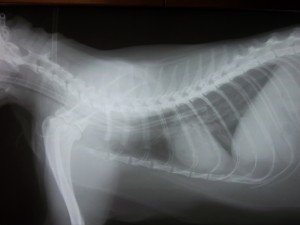“Precious” is an 8 year old female spayed cat who was referred to Welland Animal Hospital for a condition of severe chronic inflammation of the oral cavity. This inflammation extends beyond the gingiva to the mucous lining of many structures in the mouth – a disease known as chronic gingivostomatitis. (this picture does not due justice to the extent of the severe inflammation – especially in the back of the mouth).
This severe inflammation results in oral pain and discomfort and cats will eventually stop eating. The cause of this condition is unknown but is most likely an immune mediated reaction secondary to bacteria (plaque) vs food antigens vs environmental antigens vs viruses vs other.
Bloodwork (CBC + biochemistry) on Precious was within normal limits and she was negative for feline leukemia and feline immunodefiency virus. Routine dentistries and homecare had not controlled the inflammation in the oral cavity and despite pain medication Precious had stopped eating for several days prior to presentation. In most cases the objective for these cats is to obtain a pain free oral cavity which is best achieved by doing a full mouth extraction (removal of all the teeth). Domestic cats do not need teeth to live long and happy lives and this provides the best long term resolution of inflammation – about 60 % complete remission. Some cats may still require adjunctive treatment post full mouth extractions. Referral to a veterinary dentist was advised but was not possible in this case so Precious was referred to our hospital.
Whole mouth intra oral radiographs were taken (see one below)
local anesthetics were given ( to aid in post -operative pain control) and all teeth and roots were extracted and alveoli were cleaned of all periodontal ligaments. Post operative rads revealed all teeth were completely removed. All extraction sites were closed with gingival flaps using absorbable sutures.
Because of Precious’s poor appetite prior to the dental an esphagotomy tube was placed in her left neck during the dental so she could be fed post operatively. (see radiograph of chest showing feeding tube placement)
Precious recovered well from the long aneasthetic and feedings were begun the next day through the esophagotomy tube. She was gradually weaned off IV fluids and pain medications and began eating some on her own 2 days post op. The feeding tube was removed 4 days post – op and Precious was sent home. She was subsequently treated with anti-inflammatories 2 weeks post dental which seem to have greatly reduced the inflammation in the caudal oral cavity and she is currently eating well.
Chronic gingivostomatitis is a painful debilitating disease which at this time is best treated by whole mouth extraction. This is the best hope for a pain free mouth in cats that are suffering from this particular disease. Routine oral and dental examination by your veterinarian is essential in diagnosing this condition early.







